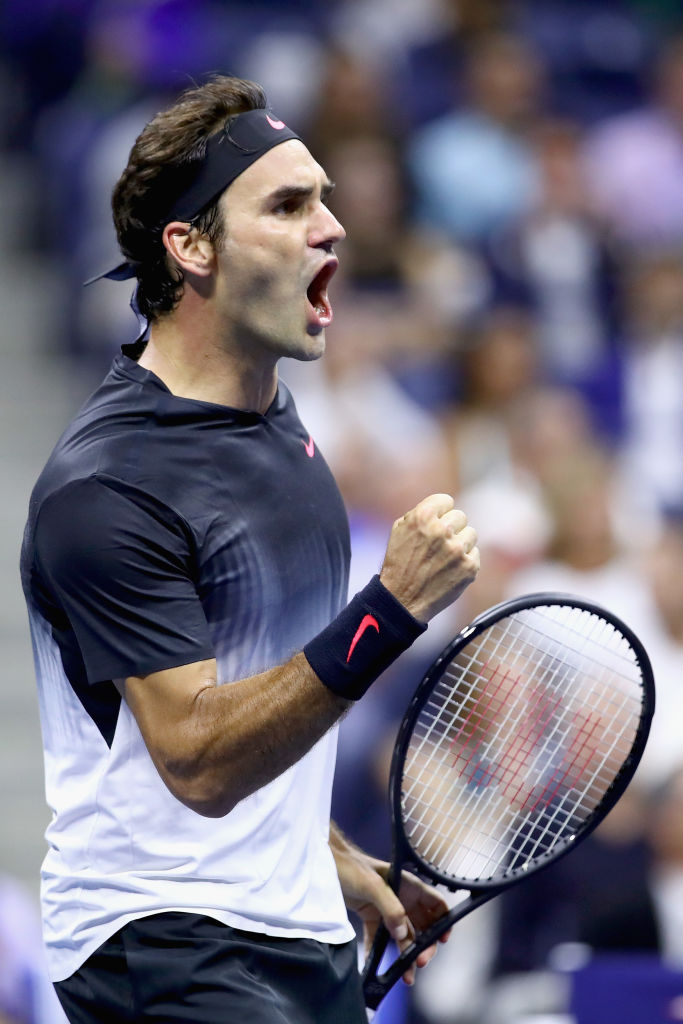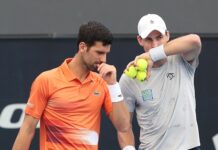Outside Ashe Stadium the August night was raw and rainy – as if it were fall. Inside Ashe Stadium over 23,000 fans figured there was no way the king would fall.
After all, this year Federer has been in full flight. The man who moves like a whisper has been shouting loud all season. He won the Australian and Wimbledon – and two Masters Series, Indian Wells and Miami. Certainly, in a diminished Open field, the not-yet-creaky 36-year-old was one of the favorites. If Roger were to win a third Slam, it would be one of the greatest achievements in sports history. Attention stone masons: start carving up Mt. Rushmore.
John McEnroe noted that in all of his 41 years in tennis, “This is the most extraordinary year I’ve ever seen, considering what Roger is doing.”
Considering the mountains Roger has scaled this year, certainly his first round match would be a modest hill hike for the champion who’d never lost in the first round at the US Open.
His foe – the lad they call Tiafoe – was just a kid, ranked No. 70. He’d never gotten beyond the second round of a Slam. And get this: while Frances is just 19, Federer has won 19 Slams. “What has Federer not done in this sport?” asked a reporter in the media cafeteria. One had to think. Well, he’d never claimed an Olympic gold medal in singles and he had never played under Arthur Ashe Stadium’s mammoth roof. But Roger is a superb indoor player who adeptly adapts – so no problemo.
But not tonight.
Roger emerged awkwardly. He seemed off-center and peeved. Mr. Calm was actually rattled. Was he offended by all the din and rumble of the arena that somehow takes the focus off the game? In any case, his serve lacked rhythm, his movement was leaden. Was he still feeling the effects of the aching back which had done him in a few weeks ago in Montreal? Why was he so off balance?
In the first game his groundies faltered, and when he shanked a backhand to give Tiafoe the game, the brash kid leapt with young bravado. Then, despite two double faults, Tiafoe backed up his break to go up 2-0. Blasting 97 mph forehands, serving like a phenom, Tiafoe raced to a 6-4 first set win.
Okay, the Open’s two other front-runners – Rafa Nadal and young Alexander Zverev – had already endured dicey scares. Still, the Ashe crowd was stunned. While Roger seemed to be a shell of himself, the black man in all black, the oh-so-appealing American prospect, was in the stratosphere. But would he come to earth? Broadcaster Chris Fowler stated the obvious: “Roger has a lot to clean up.” Federer admitted that his eye was off and he was misjudging distance. But then, as we anticipated, Tiafoe indeed came to earth.
Rather suddenly, his serve slowed and his groundies became errant. In the fourth game of the second set a makeable backhand flew wide and Roger gained his first break of the match. Federer and his fans could at last exhale as he went up 3-1 and got in gear. Almost in a flash, the man of grace was now in full form. Forehand to the corner, backhand flowing, flawless overhead, decisive volley. Fluid, forceful and fine – simply put, Federer was now Federer. One thought of writer Sue Mott’s claim that dictionary writers needed to make up a new verb, “to Federer, to demolish with gasp-inducing precision..”
Tiafoe later told IT that Roger is the greatest in so many ways: “You can’t read his serve. He jumps on the return ball better than anyone. Doesn’t give the baseline up…Best mover, by far. He sees the game completely different[ly] from everybody else.” Tiafoe – his errors mounting, his spirit falling – only won three games in two sets as Roger sprinted to a commanding 4-6, 6-2, 6-1 lead.
Now Tiafoe would surely show proper deference to his elder and go home – at least knowing, with great pride, that he’d taken a set off the greatest player of all time. But Federer played a loose game in the fourth game of the fourth set, to allow Tiafoe to break to go up 3-1. Suddenly the momentum had whiplashed. Roger had lost his rhythm on serve, his control of his groundies and even the favor of the once adoring crowd, as Tiafoe again broke, and howled to the crowd when he claimed a 6-1 fourth set win in just 24 minutes.
Now, after two lightning hours filled with shock, thunder and quicksilver shifts, the Swiss man who didn’t lose a set at Wimbledon had dropped two sets to a teen.
In the fifth set, the crowd seemed to come to its senses and say, “That was fun – we’ve had our fling with that hunky kid.” Not surprisingly, they roared when Federer won the first game. But the moment of truth came in the fourth game, when Tiafoe made a grievous rookie error and hit an ill-considered dropshot that Roger pounded with a confident backhand winner to score a break, to go up 3-1.
Then again, Roger has long told us that tennis is all about decision-making, both long range and in split seconds on court.
This was the crack in Tiafoe’s wall that Roger opened wide. Yes, to his great credit, Frances did manage to break Federer to get back on serve. But Roger had the momentum, the confidence, the experience, the resilience and the range of shots to prevail. And after 2 hours 37 minutes of exquisite battle, on Federer’s third match point, Tiafoe slipped, and hit an inglorious backhand into the net to give the battle to a glorious player 4-6, 6-2, 6-1, 1-6, 6-4.
Just before midnight in Ashe Stadium, the mind flashes back to other great US Open moments: the night in 1997 when this massive arena opened. The moment in 2005 in the finest night match in US Open history, when a critical James Blake forehand blast, which should have led to his victory over Andre Agassi, missed by a fateful inch. And most of all, one thinks of the singular Jimmy Connors, who during his fabled 1991 run to the semis, shouted to a camera the immortal words, “This is what they want and this is what they’ll get!”
Tonight, howling New Yorkers wanted to see a triumph by the ascendant Federer, the man who glows rather than sweats. At the same time they wanted to relish a gritty gladiatorial battle. So, unlike Wimbledon, where Roger elegantly flowed and won 21 straight sets with disarming ease, here the master twitched. The game’s poet laureate had to morph into a street-fighting man. We saw the great battler shout, “Tennis world, I’m not done yet!” Our greatest player reminded us that true champions find a way no matter the obstacle, even if it is a kid with a big forehand, a big heart and a big future.
Ultimately, Roger got only one thing wrong. He told the throng how lucky he was.
Wrong, Roger. We were the lucky ones.



















